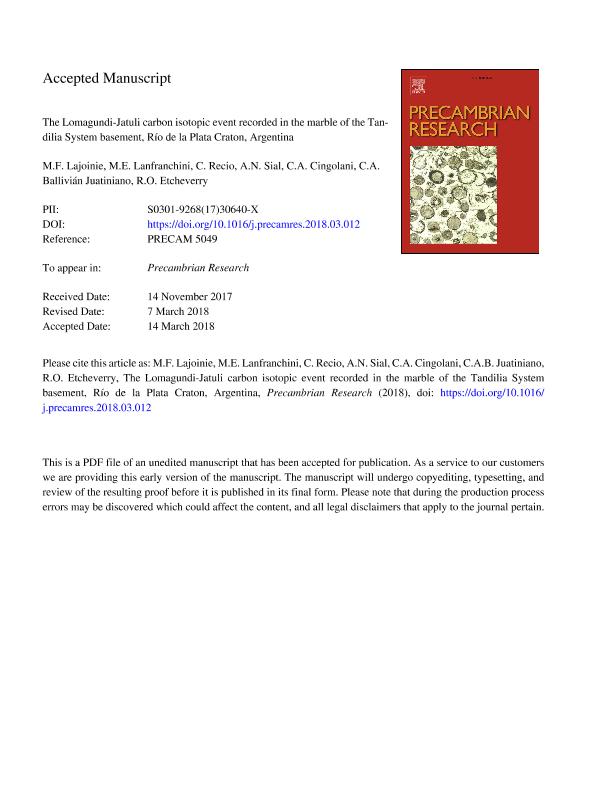Artículo
The Lomagundi-Jatuli carbon isotopic event recorded in the marble of the Tandilia System basement, Río de la Plata Craton, Argentina
Lajoinie, Maria Florencia ; Lanfranchini, Mabel Elena
; Lanfranchini, Mabel Elena ; Recio, C.; Sial, A.N.; Cingolani, Carlos Alberto
; Recio, C.; Sial, A.N.; Cingolani, Carlos Alberto ; Ballivian Justiniano, Carlos Alberto
; Ballivian Justiniano, Carlos Alberto ; Etcheverry, Ricardo Oscar
; Etcheverry, Ricardo Oscar
 ; Lanfranchini, Mabel Elena
; Lanfranchini, Mabel Elena ; Recio, C.; Sial, A.N.; Cingolani, Carlos Alberto
; Recio, C.; Sial, A.N.; Cingolani, Carlos Alberto ; Ballivian Justiniano, Carlos Alberto
; Ballivian Justiniano, Carlos Alberto ; Etcheverry, Ricardo Oscar
; Etcheverry, Ricardo Oscar
Fecha de publicación:
06/2019
Editorial:
Elsevier Science
Revista:
Precambrian Research
ISSN:
0301-9268
Idioma:
Inglés
Tipo de recurso:
Artículo publicado
Clasificación temática:
Resumen
The “Lomagundi-Jatuli event” corresponds to the most important δ13C positive anomaly (≥5‰) globally reported in Palaeoproterozoic marine carbonates (between ∼2.30 and 2.06 Ga). In the Tandilia System (Argentina), Río de la Plata Craton, this event was recorded in the basement marble of the San Miguel area. The calcite-diopside marble, hosted by biotite gneiss and intruded by 2.12 Ga garnet-leucogranite, was metamorphosed in amphibolite facies during the Transamazonian Cycle. PAAS-normalised rare-earth elements (REE) and Y for the carbonate rocks are HREE-enriched and display positive Eu and Y anomalies, typical of primary precipitates from a mixed hydrothermal-marine environment carbonate. Additionally, a truly negative Ce anomaly for all the samples indicates that the depositional environment was oxidising. Positive δ13C values ranging from +5.90 to +4.30‰ (V-PDB), and δ18O from +17.45 to +13.84‰ (V-SMOW) were determined in this marble, both gradually decreasing towards the contact with the leucogranites. These values indicate that devolatilization reactions took place during the crystallisation of a wollastonite-vesuvianite-grossular-diopside skarn generated by the leucogranite intrusions into the marble. δ18O values obtained from diopside and calcite crystals, in the marble sectors furthest from the contacts with leucogranite, allowed a 663–623 °C formation temperature to be calculated, considering oxygen in a calcite-diopside geothermometric pair. These temperatures are consistent with the metamorphic degree (amphibolite facies) reached in this portion of the basement. Although the San Miguel marble shows petrographic and mineralogical evidence of regional and contact metamorphism, important geochemical and isotopic characteristics, together with its estimated Palaeoproterozoic age, indicate that the marble protolith was a marine carbonate deposited during the “Lomagundi-Jatuli event”.
Archivos asociados
Licencia
Identificadores
Colecciones
Articulos(CCT - LA PLATA)
Articulos de CTRO.CIENTIFICO TECNOL.CONICET - LA PLATA
Articulos de CTRO.CIENTIFICO TECNOL.CONICET - LA PLATA
Citación
Lajoinie, Maria Florencia; Lanfranchini, Mabel Elena; Recio, C.; Sial, A.N.; Cingolani, Carlos Alberto; et al.; The Lomagundi-Jatuli carbon isotopic event recorded in the marble of the Tandilia System basement, Río de la Plata Craton, Argentina; Elsevier Science; Precambrian Research; 326; 6-2019; 447-461
Compartir
Altmétricas



